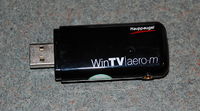Hauppauge WinTV-Aero-m: Difference between revisions
| Line 41: | Line 41: | ||
===Drivers=== |
===Drivers=== |
||
The WinTV Aero-m uses the mxl111sf driver, which is part of the kernel. |
|||
===Sample Kernel Output=== |
===Sample Kernel Output=== |
||
Revision as of 01:13, 23 January 2019
A hybrid mulitple frontend (MFE) Digital TV USB 2.0 device, by Hauppauge, featuring reception capabilities for ATSC, ATSC-M/H and DVB-T.
It is supported under Linux; since kernel 3.2 for ATSC & DVB-T and kernel 3.5 for ATSC-M/H support.
Overview/Features
- Very nice form factor (i.e. has a small physical footprint).
- A first of a kind type of device -- supports both DVB-T and ATSC (as well as the M/H subset) ... Note: this dual support is only available under Linux (Windows drivers will only expose the digital TV standard relative to the location it was purchased i.e. ATSC in N.A, DVB-T in Europe)
- Has a built-in, telescoping, aerial (i.e. a "whip" antenna)
- Credit card sized IR remote control (battery included), with the Aero-m itself sporting an IR receiver on its front
- Port for external antenna attachment (RF cable adapter plug included)
- Removable cap for the USB 2.0 connector
- USB 2.0 extension cable (roughly 13inches; one foot usable length once you plug both ends in)
- Windows driver CD and Installation guide
Components Used
- MaxLinear MxL111SF SoC
- tuner
- DVB-T demodulator
- USB 2.0 bridge
- LG DT3305 demodulator (D)
- LG LG2161 demodulator (D-m)
Identification
The output of lsusb -v reveals that the device has a subsystem ID of: 2040:c61b
Other Images
Making it Work
Firmware
No firmware is required for this device
Drivers
The WinTV Aero-m uses the mxl111sf driver, which is part of the kernel.
Sample Kernel Output
Relevant dmesg output:
[ 3874.201858] usb 1-4.1.2: new high-speed USB device number 15 using ehci_hcd [ 3874.288007] usb 1-4.1.2: New USB device found, idVendor=2040, idProduct=c61b [ 3874.288011] usb 1-4.1.2: New USB device strings: Mfr=1, Product=2, SerialNumber=3 [ 3874.288013] usb 1-4.1.2: Product: WinTV Aero-M [ 3874.288015] usb 1-4.1.2: Manufacturer: Hauppauge [ 3874.288016] usb 1-4.1.2: SerialNumber: 4034349227 [ 3874.288293] dvb-usb: found a 'Hauppauge WinTV-Aero-M' in warm state. [ 3874.288324] dvb-usb: will pass the complete MPEG2 transport stream to the software demuxer. [ 3874.288325] dvb-usb: will pass the complete MPEG2 transport stream to the software demuxer. [ 3874.288326] dvb-usb: will pass the complete MPEG2 transport stream to the software demuxer. <-- only for kernel 3.5 and up [ 3874.288648] DVB: registering new adapter (Hauppauge WinTV-Aero-M) [ 3874.552658] DVB: registering adapter 0 frontend 0 (LG Electronics LGDT3305 VSB/QAM Frontend)... [ 3874.570179] DVB: registering adapter 0 frontend 1 (MaxLinear MxL111SF DVB-T demodulator)... [ 3874.738637] mxl111sf: MxL111SF detected, v8_200 (0x18) [ 3874.741930] DVB: registering adapter 0 frontend 2 (LG Electronics LG2161 ATSC/MH Frontend)... <-- only for kernel 3.5 and up [ 3874.742968] dvb-usb: Hauppauge WinTV-Aero-M successfully initialized and connected. [ 3874.766943] tveeprom 14-0050: Hauppauge model 126001, rev F1G4, serial# 7817387 [ 3874.766946] tveeprom 14-0050: MAC address is 00:0d:fe:77:48:ab [ 3874.766948] tveeprom 14-0050: tuner model is MaxLinear 111 (idx 164, type 4) [ 3874.766950] tveeprom 14-0050: TV standards ATSC/DVB Digital (eeprom 0x80) [ 3874.766951] tveeprom 14-0050: audio processor is None (idx 0) [ 3874.766952] tveeprom 14-0050: has no radio, has IR receiver, has no IR transmitter
Note: the above output is with a kernel version 3.5, and all 3 frontends on the adapter are registered. The output above is annotated to note the difference if you are using a pre version 3.5 kernel.
Remote Control Support
The remote has been successfully tested under Linux during driver development, however, said support is currently disabled, but will likely will be re-introduced in the near future.
User Experience
See the article's discussion page



